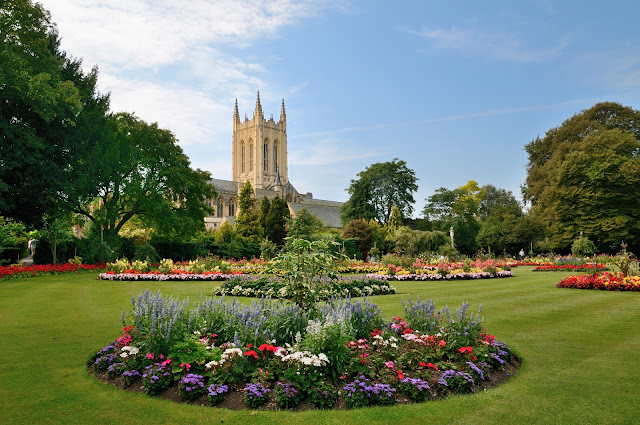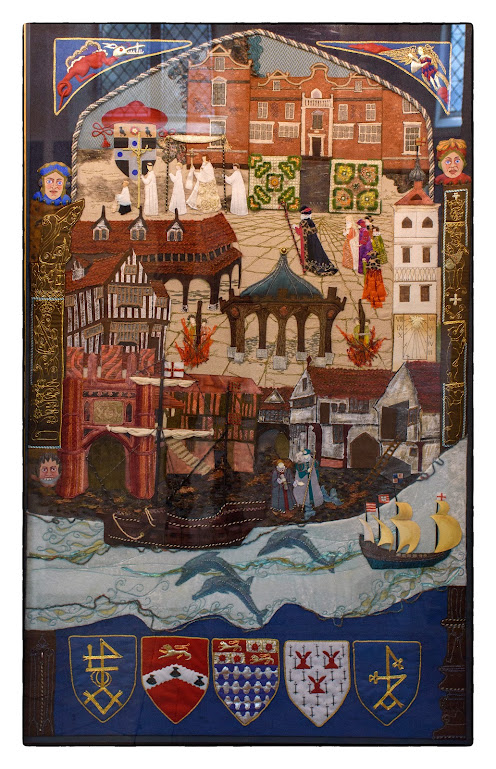The Ipswich Charter Wall Hangings were researched and designed by Isabel Clover. The panels were embroidered by City and Guilds students from Suffolk College at the turn of the Millennium. Each of the eight panels is a graphic representation of Ipswich in the centuries since the town was granted its charter in 1200AD.
Embroidery is the embellishment of fabric with needlework; the panels demonstrate a wealth of techniques and applied materials to represent architectural styles, different forms of transport and Ipswich’s treasures.
The panels were born out of an idea by Ferial Rogers of the Ipswich Arts Association who, when discussing ways to mark the Millennium, suggested some kind of tapestry. Such needle-works have long been used to mark important occasions and historical events, most notable among them no doubt the Bayeux Tapestry.
A simple idea that, with Isabel’s experience in ecclesiastical designs and embroidery, became a major project. On a technicality, I am repeatedly reminded by my wife that neither the Bayeux nor the Charter Hangings are tapestries. Tapestries or hangings, they are a very suitable and fitting way to mark the occasion.
The initial idea of a panel for each century was revised so that the first panel could represent Ipswich in the period pre-dating the Charter (ie before 1200AD). There was a not insubstantial cost to creating the panels (despite the volunteer labour) and the Ipswich Arts Association set about fundraising. Sponsorship was secured from some of the owners and occupiers of the buildings featured and valuable contributions were made by members of the public. The panels took three years of research, design and craftsmanship to complete with the final results received to great acclaim.
The feature that links all eight is the river which runs through the bottom third of each panel, created in silk velvet, dyed with silk dyes and stitched with silk thread. It was accepted that over a long period of time the panels would fade but then so do the buildings featured, just as the river changes colour with the tide.
Using volunteers to create the panels was both a challenge and the source of much inspiration. The diversity of talent was bound to lead to different standards of workmanship but Isabel, who had the final word, frequently suggested pieces were reworked. The result is that the finished panels are of professional quality with unity and harmony. It is often suggested that to create a great painting you do not cut the canvas into jigsaw pieces and ask different individuals to each fashion their small section but this is exactly what happened here.
Isabel selected the person whose creative ability and known skills suited the piece to be crafted. The gold work was particularly difficult but was masterfully completed by Isabel’s church embroidery students, their collective years of experience reflected in the finished pieces. It was essential that throughout the creative process the students worked together to ensure the overall result was as required, the pieces fitted together and the finished panel created an impression of the period it was designed to represent. The result is a marvel fit for the 21st Century. The Charter Wall Hangings are on display in St Peter’s Church and can be seen every Wednesday between 10am and 3.30pm.
If you’ve seen the panels previously take another look, there is always something new to find. If you’ve never seen them then you really are missing out on one of Ipswich’s true icons.
This is one of the hangings - The Tudor Period (16th Century)
At the beginning ot the Tudor period Ipswich was stil Catholic. Many pilgrims came to the townto visit the shrine of Our Lady of Ipswich, eventhe royal pilgrims Henry VIII and Katherine of Aragon. At the top of the hangings, clergy and townspeople process to the shrine. Ipswich was the birthplace of Cardinal Thomas Wolsey, and his coat of arms is at the top, surmounted by his Cardinal`s hat; while at the bottom of the post, on the left a butcher`s boy with a knifein his mouth reminds us that Wolsey`s father was a butcher. Next to him is all that remains of his grand plan for a college: a waterside gateway.
At the top of the panel are two spandrel carvings, St Michael the archangel on the right and the Dragon on the left. They were carved on the entrance to the White Hart which stood on the site of Brook Street Craft Market.
On the Cornhill stood the Market Cross, removed in 1812. Two carved and painted heads top the corner posts on each of the hangings. The post on the left comes from Brown`s Yard, that on the right from the inn opposite the Ancient House in Dial Lane. Both are now in the Museum.
The Shambles (slaughter house) stood on the Cornhill and below this is the Royal Oak, still standing in Northgate Street at the corner of Oak lane. During this time of religious strife martyrs were burned on the Cornhill; groups are shown suffering on either side of the market cross.
Large new properties were erected on sites of religious houses suppressed or dissolved by Henry VIII. Christchurch, built on the site of the Augustinian Priory, is shown at the top of the hanging, with two of its original knot gardens in front.The mansion is now part of the Ipswich Museum. Below it is the tower of Great Place built for Sir Thomas Seckford in Westgate Street. At its base is the sundial from Smart`s Wharf on the docks, inscribed `Why stand you here idle while time passes`.
This was another prosperous time for the town, the port being used by many wealthy merchants. At the bottom of the hanging are depicted, from left to right, the merchant`s mark of Thomas Pownder and the coat of arms of Henry Toole, the Merchant Adventurers and William Smart, with the merchant`s mark of Thomas Drayll on the far right.
The ship on the river, the Mary Walsingha, belonging to Henry Tooley, a merchant fishing in Icelandic waters. The smaller ship, the Desire, took Thomas Cavendish of Trimley and Thomas Eldred around the world in the 1560`s. The grampusses, or porpoises, were washed up further down the Orwell. As they traditionally belonged to the king, their tails and fins were cut off and sent to him in London.
On the wharf to the right of Wolsey`s Gate is the inner court of the Issac Lord building, well restored today. Between this and the Quay is the magnificent hall and meeting place of the Merchant Adventurers which also remains.The other buildings are from Brown`s Yard.

For at least nine centuries a church has stood on this spot as a place for the community, whether it be congregations, lovers of music and the arts or model train enthusiasts!
As a church, St Peter’s served a large parish and the mariners who came into a port bustling with activity during the middle ages, first, probably as a building made of wood then on to a stone made building, which formed part of the Augustinian Priory of St Peter and St Paul during the late 12th century.
It is at this time that the magnificent Tournai Marble font, with its enormous bowl and prowling lions came to St Peter’s. One of only 10 in England and made from a type of limestone from around the town of Tournai in Belgium. (ABOVE)
Fast forward to the tudor period and St Peter’s gains prominence as Ipswich’s greatest son Cardinal Thomas Wolsey closes the Priory to use the church as the chapel to his College of the Blessed Virgin Mary.
During this period many changes were made to the building including the repositioning of the tower, addition of the north and south aisles and a new chancel.
Wolsey’s college was short lived when he fell out of favour with King Henry VIII and died in disgrace in 1530 and not long after St Peter’s was given back to the parishioners. Along with the church, the “Wolsey Gate”, a watergate on College Street are all that remains of his grand plans.
This gateway was once in the corner of St Peters Churchyard and is the only obvious reminder of the school founded by Thomas, Cardinal Wolsey, a native of Ipswich who rose to become the most powerful man in the kingdom under Henry VIII.
In modern times St Peter`s has fulfilled many functions, which is great, as the building is kept for future generations and a lot of its beauty can still be appreciated. As you can see from the above image, what was the sanctuary is now the stage for music performances.











%20burial%20chamber_3.JPG)
%20burial%20chamber_1.JPG)






































